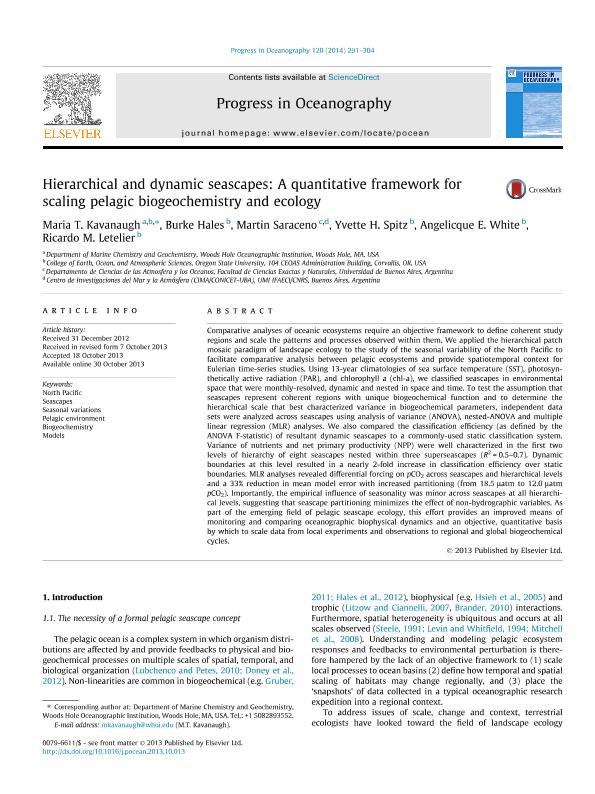Mostrar el registro sencillo del ítem
dc.contributor.author
Kavanaugh, Maria T.
dc.contributor.author
Hales, Burke
dc.contributor.author
Saraceno, Martin

dc.contributor.author
Spitz, Yvette H.
dc.contributor.author
White, Angelicque E.
dc.contributor.author
Letelier, Ricardo M.
dc.date.available
2016-02-25T19:30:30Z
dc.date.issued
2014-01
dc.identifier.citation
Kavanaugh, Maria T.; Hales, Burke; Saraceno, Martin; Spitz, Yvette H.; White, Angelicque E.; et al.; Hierarchical and dynamic seascapes: a quantitative framework for scaling pelagic biogeochemistry and ecology; Elsevier; Progress In Oceanography; 120; 1-2014; 291-304
dc.identifier.issn
0079-6611
dc.identifier.uri
http://hdl.handle.net/11336/4441
dc.description.abstract
Comparative analyses of oceanic ecosystems require an objective framework to define coherent study regions and scale the patterns and processes observed within them. We applied the hierarchical patch mosaic paradigm of landscape ecology to the study of the seasonal variability of the North Pacific to facilitate comparative analysis between pelagic ecosystems and provide spatiotemporal context for Eulerian time-series studies. Using 13-year climatologies of sea surface temperature (SST), photosyn- thetically active radiation (PAR), and chlorophyll a (chl-a), we classified seascapes in environmental space that were monthly-resolved, dynamic and nested in space and time. To test the assumption that seascapes represent coherent regions with unique biogeochemical function and to determine the hierarchical scale that best characterized variance in biogeochemical parameters, independent data sets were analyzed across seascapes using analysis of variance (ANOVA), nested-ANOVA and multiple linear regression (MLR) analyses. We also compared the classification efficiency (as defined by the ANOVA F-statistic) of resultant dynamic seascapes to a commonly-used static classification system. Variance of nutrients and net primary productivity (NPP) were well characterized in the first two levels of hierarchy of eight seascapes nested within three superseascapes (R2 = 0.5?0.7). Dynamic boundaries at this level resulted in a nearly 2-fold increase in classification efficiency over static boundaries. MLR analyses revealed differential forcing on pCO2 across seascapes and hierarchical levels and a 33% reduction in mean model error with increased partitioning (from 18.5 latm to 12.0 latm pCO2). Importantly, the empirical influence of seasonality was minor across seascapes at all hierarchi- cal levels, suggesting that seascape partitioning minimizes the effect of non-hydrographic variables. As part of the emerging field of pelagic seascape ecology, this effort provides an improved means of monitoring and comparing oceanographic biophysical dynamics and an objective, quantitative basis by which to scale data from local experiments and observations to regional and global biogeochemical cycles.
dc.format
application/pdf
dc.language.iso
eng
dc.publisher
Elsevier

dc.rights
info:eu-repo/semantics/openAccess
dc.rights.uri
https://creativecommons.org/licenses/by-nc-nd/2.5/ar/
dc.subject
North Pacific
dc.subject
Seascapes
dc.subject
Seasonal Variations
dc.subject
Pelagic Environment
dc.subject
Biogeochemistry
dc.subject.classification
Oceanografía, Hidrología, Recursos Hídricos

dc.subject.classification
Ciencias de la Tierra y relacionadas con el Medio Ambiente

dc.subject.classification
CIENCIAS NATURALES Y EXACTAS

dc.title
Hierarchical and dynamic seascapes: a quantitative framework for scaling pelagic biogeochemistry and ecology
dc.type
info:eu-repo/semantics/article
dc.type
info:ar-repo/semantics/artículo
dc.type
info:eu-repo/semantics/publishedVersion
dc.date.updated
2016-03-30 10:35:44.97925-03
dc.journal.volume
120
dc.journal.pagination
291-304
dc.journal.pais
Países Bajos

dc.journal.ciudad
Amsterdam
dc.description.fil
Fil: Kavanaugh, Maria T.. Woods Hole Oceanographic Institution. Department of Marine Chemistry and Geochemistry; Estados Unidos. Oregon State University. College of Earth, Ocean, and Atmospheric Sciences; Estados Unidos
dc.description.fil
Fil: Hales, Burke. Oregon State University. College of Earth, Ocean, and Atmospheric Sciences; Estados Unidos
dc.description.fil
Fil: Saraceno, Martin. Consejo Nacional de Investigaciones Científicas y Técnicas. Oficina de Coordinacion Administrativa Ciudad Universitaria. Centro de Investigaciones del Mar y la Atmósfera; Argentina. Universidad de Buenos Aires. Facultad de Ciencias Exactas y Naturales. Departamento de Ciencias de la Atmósfera y los Océanos; Argentina
dc.description.fil
Fil: Spitz, Yvette H.. Oregon State University. College of Earth, Ocean, and Atmospheric Sciences; Estados Unidos
dc.description.fil
Fil: White, Angelicque E.. Oregon State University. College of Earth, Ocean, and Atmospheric Sciences; Estados Unidos
dc.description.fil
Fil: Letelier, Ricardo M.. Oregon State University. College of Earth, Ocean, and Atmospheric Sciences; Estados Unidos
dc.journal.title
Progress In Oceanography

dc.relation.alternativeid
info:eu-repo/semantics/altIdentifier/url/http://www.sciencedirect.com/science/article/pii/S007966111300205X
dc.relation.alternativeid
info:eu-repo/semantics/altIdentifier/issn/0079-6611
dc.relation.alternativeid
info:eu-repo/semantics/altIdentifier/doi/http://dx.doi.org/10.1016/j.pocean.2013.10.013
Archivos asociados
